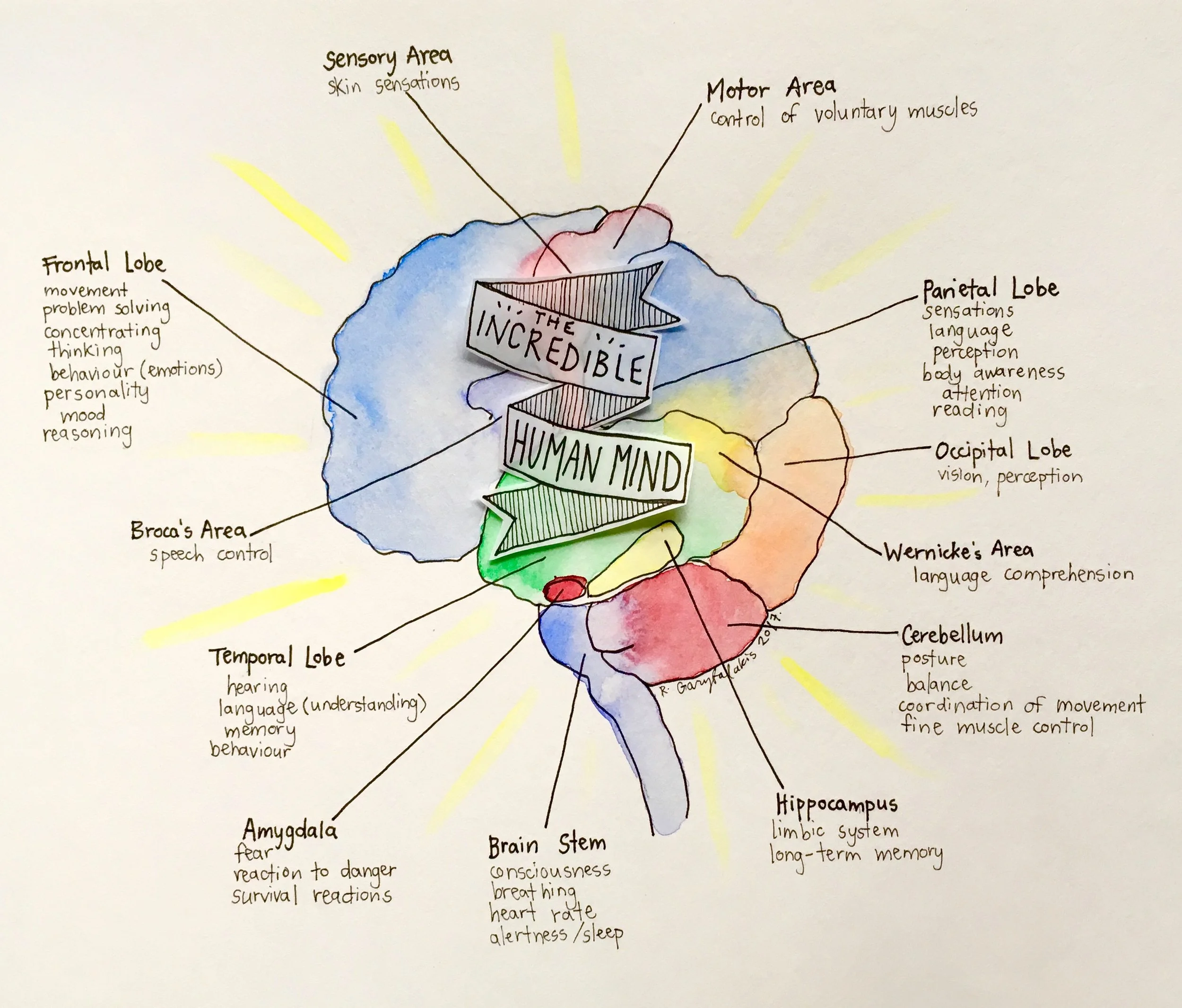It’s mid January and we are well into cold and flu season. We all know the signs and symptoms – chills, sniffles, glassy eyes, hot forehead, sore throat, and generally tired cranky kids (and adults!). And we also know what to do – we head home, drink lots of liquids, rest on the couch, take vitamin C, keep fevers down with medicine, make soup, and give lots of hugs and cuddles. If there’s no improvement after a few days, we go to the doctor for some expert advice. We know how to take care of our physical bodies during cold and flu season. In general, we’re pretty good at paying attention to our physical bodies when they need something. If we get a cut, our bodies bleed and we clean the cut and put a bandage on. If we have a sore tooth, we head to the dentist to get it checked out. Taking care of our physical health is an accepted part of our culture. We talk about these things openly, we share remedies and we send sympathy. But what about mental health? What about taking care of our minds?
At Art as Therapy we are strong believers in the mind-body connection. In other words, the way that we think impacts the way that we feel, and the way that we feel in our physical bodies can impact the way that we think about ourselves and the world. Our minds are part of our physical bodies, yet taking care of our minds is somehow in a separate category that we designate specific days to talking about. Unfortunately there is a stigma attached to the words “mental health,” despite the fact that every single one of us has mental health just like we all have physical health. And just like our physical bodies need attention and care from time to time, so do our minds. There’s no shame in this. At Art as Therapy, our vision is to share information and to normalize the notion of mental health until taking care of our minds is integrated into our culture just like taking care of our physical health.
In our work with children, we often ask them to draw or tell what is inside their bodies. Even very small children know about their heart, lungs, stomach, blood, veins, bones… but when they get to their heads there is a real sense of mystery. They know there’s a brain inside their heads, but then it gets convoluted. Is this where the thoughts are? Where are the feelings? What about the bad dreams? Where do they come from?
It’s true that the human brain is complex and we are still learning more about it each day. But we already know a lot! And it’s really important that we get to know our brains, and teach our children about their brains too. The illustration with this post highlights the main areas of the brain, and lists a few of the functions each area is responsible for. Isn’t it incredible? Our brains control and influence our speech, our vision, our balance, our muscle movements, our sensory experiences, our memory, our problem solving skills, our attention, and our emotions. In fact, our brains influence everything we think, say, and do. And likewise – the things we eat, watch, play, hear, and see influence how our brains operate. The first step in taking care of our minds is getting to know how they work and what they need.
When we talk about mental health, we usually focus on what can go wrong. It’s as if when our brains are functioning as we think they should, then we don’t have mental health. But this is not true! Just like we now know that heart disease can often be prevented through diet, exercise, and lifestyle, we also know that there are things we can do to strengthen our minds and take care of them before something isn’t working.
Art therapy is one way that you can take care of your mind. Did you know that an art therapy session engages nearly every part of your brain?
· Frontal lobe – problem solving required to complete art tasks, requires concentration and complex thinking. Art tasks invite clients to get in touch with their emotions and express them in multiple ways.
· Broca’s area – engaged through conversation with the therapist.
· Temporal lobe – memory is activated through associations. Hearing is required to converse with the therapist. Art therapy sessions often incorporate music.
· Amygdala – may be activated when attending a new office, meeting the therapist for the first time, or trying a new task.
· Brain stem – breathing and heart rate may be influenced by the art task, breathing exercises are often used in art therapy to help clients to ground themselves and experience a sense of calm or focus.
· Hippocampus – long term memory may be activated through associations with artwork or art materials.
· Cerebellum – fine muscle control is needed for working with art supplies.
· Wernicke’s Area – used for understanding and speaking with the therapist.
· Occipital Lobe – vision and perception are used when creating and reflecting on artwork.
· Parietal Lobe – used to focus on art tasks, perception is engaged when reflecting on artwork.
· Motor Area – voluntary muscles are engaged when sitting at the art table, or catching a ball during a warm up activity.
· Sensory Area – senses are engaged through the smell, texture, colour, sound of art materials and art making experiences.
Not only is art therapy a great way to engage your mind and exercise each part (kind of like a workout for your physical body), it is also a great opportunity to get to know your mind a bit better. The frontal lobe works very hard to control your thoughts and sometimes it can feel like your conscious thoughts are the only part of your mind. But art therapy allows you to tap into the more unconscious parts of your mind, and allows the less rational or controlled parts to express themselves. Sometimes this process allows clients to make discoveries about how they feel or gain insight into why they behave the way they do in certain situations. When we give space to the other parts of our brains, we can hear from them and learn more about ourselves and what we may need to be healthy.
Sometimes art therapy can help clients to recognize something that needs attention in the mind, for example art therapy can help shift unhelpful thinking patterns (check out this blog post about managing anxious thoughts: “Open in Case of Anxiety”). Art therapy can also help with behavioural change by shifting the way clients think and feel about themselves (here’s a blog post about boosting self esteem through chores: How to boost your child’s self esteem…).
Art therapy can also be an act of self love and self care. You don’t have to be in crisis or experiencing difficulty in your life to benefit from art therapy. Art as Therapy believes in preventative care for mental health, and we support clients who are interested in art therapy as a way to get to know themselves better and to take really great care of their mental health, even when things are going well.
We hope you will join us and our friends at #BellLetsTalk in our mission to de-stigmatize mental health and promote healthy minds throughout the year! Call us at 1-519-307-9000 or email info@artastherapy.ca today to learn more about how art therapy can support mental health. Follow us on Facebook (Art as Therapy), Twitter (@artastherapy) and Instagram (@art_as_therapy) to share how you’re taking care of your mind today!
Written by Rubi Garyfalakis, Art Therapist at Art as Therapy
References:
http://www.md-health.com/Parts-Of-The-Brain-And-Function.html
http://visual.ly/look-brain
http://www.youbioit.com/es/article/20686/funciones-de-cada-parte-del-cerebro?size=_original
http://www.healthpages.org/brain-injury/brain-injury-brain-functions/

